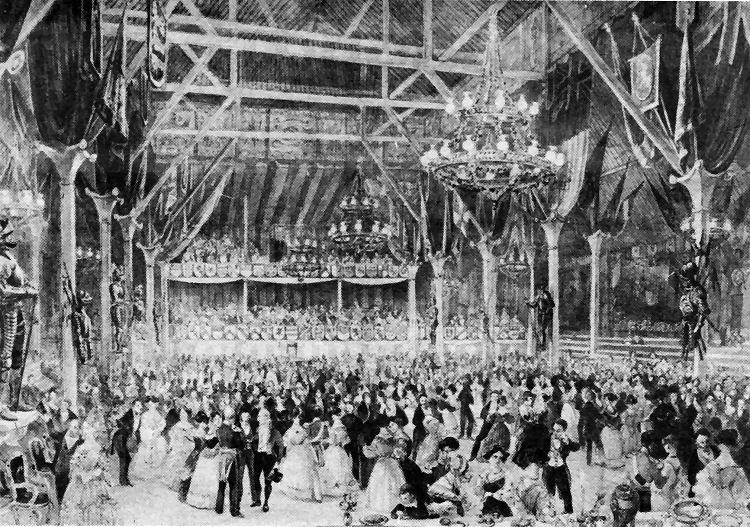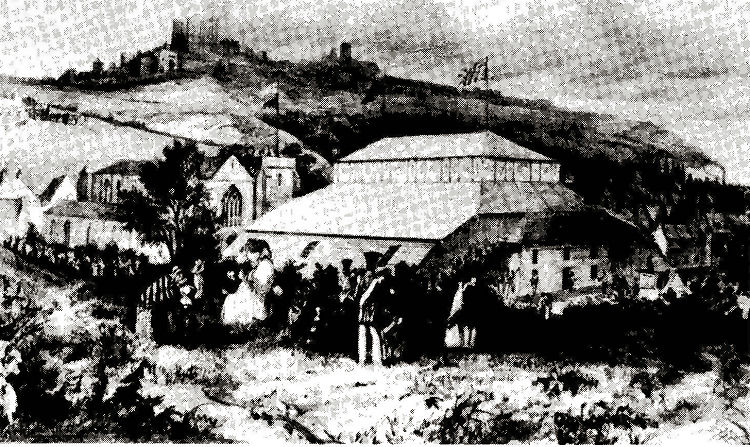Page Updated:- Sunday, 07 March, 2021. |
|||||
 Published in the South Kent Gazette, 21 January, 1981. A PERAMBULATION OF THE TOWN, PORT AND FORTRESS. PART 149.
WELLINGTON BANQUET High Street, in a deed made in the year 1400, was called Holestreet; but about 1800 it was usually styled Charlton High Road, and was wholly In the country. On the west side of it, formerly known as Baker’s Close, Roman urns and other ancient relics have been discovered. At the lower end of High Street names were used which serve as an index to dates. Victoria Crescent, for instance, belongs to the beginning of the Victorian era. The land about here was once called Baker’s Close, so named because it was land adjoining the Bakehouse of the Priory of St. Martin according to old records. Near here, too, in more recent times stood a number of cottages called Trafalgar Place, built soon after the Battle of Trafalgar. The buildings facing the Town Hall were, as late as 1903, private residences with little gardens in front and steps leading up to the main entrances, like those in Priory Road. They are now included in High Street but were then known as St. Martin’s Terrace, a name which recalls the time when the Wellington banquet took place in the Priory meadow on the 30th August, 1839. Pictures illustrating that event are still extant, showing the spot where St. Martin’s Terrace now stands as void land in front of the magnificent pavilion built for those festivities. The erection of the pavilion cost £1,200, it covered a space of 20,240 square feet, 20,000 cubic feet of timber was used in its structure, 100 men were employed 160 days in building it, and there were seats in it for 2,250 persons. The hall in the centre of the structure was nearly square, and on either side the seats rose in amphitheatre form. Pink and white striped drapery covered the internal walls, coats of arms of the Lord Wardens from Earl Godwin down to the Duke of Wellington were ranged on the walls, and pillars interspersed with stars of bayonets, groups of muskets and ancient armour. Some of the greatest nobles and statesmen in the land, the Barons of the Cinque Ports and the aristocracy of Kent and Sussex crowded that great pavilion. The Dover Telegraph and Cinque Ports Advertiser devoted seven wide columns of its newspaper the weekend following the banquet to a report of the “Grand Festival of the Cinque Ports to the Duke of Wellington“ with an apology for publishing an abbreviated version of only four columns the day after the banquet. They said they were let down by reporters engaged to cover the speech making. The event said the Telegraph was “the most brilliant affair which has, in our memory, been ever witnessed in Dover.“ The spectacle on entering the pavilion was such that it was almost impossible to put into words. “The rich colours of the banners and flags, with the varied and splendid designs of the tapestry, the gold and silver glittering In the rays of light, the innumerable number of persons present, the beauty and elegance of the ladies’ gallery, the long array of nobility and gentry, and above all the noble duke himself, created a scene, which to be appreciated as It deserved, must have been witnessed. The building consists of a nave or centre and two aisles. Immediately In front of the entrance was the chairman’s or duke’s gallery, erected for 72 persons; the front of this gallery was decorated with the coats of arms of 56 of the Lord Wardens of the Cinque Ports, from the time of Edward the Confessor, down to the reign of Henry XII. “Above the Duke’s arms, and against the ceiling, was suspended Tapestry, consisting of rich pink and white stripes. On this in the centre was the Queen’s arms, beautifully emblazoned, surrounded by flags belonging to the Cinque Ports Volunteer Regiment. Above this was placed a trophy, composed of a cuirass, helmet, and other arms, taken from the field of Waterloo. Between two stands of musquets and a scroll supported by eagles, is inscribed “WATERLOO,“ On the right of this was a magnificent fresco piece of tapestry, representing the birth of Achilles. Beyond this within an emblematical border, was the arms of William the Conqueror, the founder of the Cinque Ports, with appropriate banners on each side. The flags of the Volunteers of the Cinque Ports, in the time of George II, emblazoned with the arms of Lionel Sackville, Duke of Dorset, flanked on each side with piles of muskets, and surmounted with a most elaborate ray of swords. At the extreme end of the wall of the stairs was a handsome star composed of bayonets. On the left of the chairman’s seat was a very elegant piece of Gobeline’s tapestry, representing the Cyclops forging the anus of Archives danced around with flags. A little beyond this, answering to the arms of the Conqueror, was placed armorial bearings of the Cinque Ports, decorated with the flags of the Margate Volunteer Corps; flanked on the opposite side with muskets, and surmounted by a ray of pistols. At the further end of this wall was a brilliant star of bayonets. The nave and aisles were tastefully decorated with a variety of flags and banners, kindly furnished by Lord A. Conyngham, Sir John Rae Reid, Bart. MP: Edward Royds Rice Esq, MP; Sir Edward Knatchbull, Bart. MP: the Mayors of the Cinque Ports. &c &c. “The nave was supported by two rows of columns, six In number, around which was arrayed chequered tapestry, and above the capitals were placed flags of almost every nation, forming, as it were, a sort of arched roof. Besides these trophies, six gorgeous suits of steel armour, which were lent from the Tower of London, by the Board of Ordnance, were placed against the columns.

The interior of the Wellington Pavilion erected opposite Dover Town Hall for the Wellington Festival Banquet in August 1839, showing the lavish decorations including glittering chandeliers and suits of armour. This engraving depicts the Wellington Ball which was held a week after the banquet, and was attended by the Duke together with members of the county’s principal families and most of the leading residents of Dover and the surrounding district. Where the dining tables had stood a new dancing floor was laid for the occasion and music was provided by Mount’s band and the bands of the 90th and 27th Regiments. Over 900 attended the ball, the ladies’ gowns and the uniforms of the military presenting a kaleidoscope of colour. The Duke mingled freely with the dancers for nearly three hours.

The Wellington Pavilion which was erected opposite the Maison Dieu, to the design of a Thanet architect, to house over 2,000 attending: the banquet. The contractors were Messrs Mackenzie of Dover and Drayson, of Sandwich. Diners exceeded 1,700 in number and, in addition, there were 600 women in the galleries round the hall who were served with lighter refreshments. Among those who supplied fare for the dinner, which included venison, lamb, beef, chicken, ham, turkey, pigeon pies and lobster, were the Paris Hotel, King’s Head Hotel and the Packet Boat Inn, two fat bucks being provided by the Earl of Guilford.
|
|||||
|
If anyone should have any a better picture than any on this page, or think I should add one they have, please email me at the following address:-
|
|||||
| LAST PAGE |
|
MENU PAGE |
|
NEXT PAGE | |